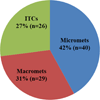Frozen section evaluation of breast carcinoma sentinel lymph nodes: a retrospective review of 1,940 cases
- PMID: 25318925
- PMCID: PMC4352298
- DOI: 10.1007/s10549-014-3161-x
Frozen section evaluation of breast carcinoma sentinel lymph nodes: a retrospective review of 1,940 cases
Abstract
Many sentinel lymph node biopsies (SLNBs) are evaluated intraoperatively by frozen section, which may impact the need for further axillary dissection (AD). However, the need for AD in patients with small metastases has been recently called into question, meaning that frozen SLNB may be unnecessary. Furthermore, frozen section can compromise tissue for further study. At our institution, we grossly evaluate all SLNB and freeze half of the node. Here, we evaluate the frozen SLNB discrepancy rate using this method, focusing on cause of discrepancy and need for further surgery. We reviewed surgical pathology records for all breast cancer resections with frozen section of SLNB examined from 2003 to 2012. For cases with a frozen section discrepancy, we compiled clinicopathologic data. In total, 1,940 cases involved frozen section evaluation of SLNB. In 95 cases (4.9% of total cases, 23.8% of positive node cases), the SLNB was called negative on frozen but positive on final examination (false negatives). The majority of missed metastases are isolated tumor cells or micrometastases. A trend was observed toward fewer patients receiving completion AD after a discrepant frozen SLNB in the later years of the study. The protocol of freezing half of a SLNB is a reasonable method, with results similar to or better than other studies. The main adverse outcome is the need for separate AD; however, additional positive nodes are uncommon. The trend of fewer patients getting additional AD after a discrepant frozen SLNB suggests that clinicians may be using this information differently recently.
Conflict of interest statement
Figures




References
-
- De Boer M, van Dijck JAAM, Bult P, Borm GF, Tjan-Heijnen VCG. Breast cancer prognosis and occult lymph node metastases, isolated tumor cells, and micrometastases. J Natl Cancer Inst. 2010;102:410–425. - PubMed
-
- Lyman GH, Giuliano AE, Somerfield MR, et al. American Society of Clinical Oncology guideline recommendations for sentinel lymph node biopsy in early-stage breast cancer. J Clin Oncol. 2005;23:7703–7720. - PubMed
-
- Lyman GH, Temin S, Edge SB, et al. Sentinel lymph node biopsy for patients with early-stage breast cancer: American Society of Clinical Oncology clinical practice guideline update. J Clin Oncol. 2014;32:1365–1383. - PubMed
-
- Krag DN, Anderson SJ, Julian TB, et al. Sentinel-lymph-node resection compared with conventional axillary-lymph-node dissection in clinically node-negative patients with breast cancer: overall survival findings from the NSABP B-32 randomised phase 3 trial. Lancet Oncol. 2010;11:927–933. - PMC - PubMed
MeSH terms
Grants and funding
LinkOut - more resources
Full Text Sources
Other Literature Sources
Medical
Miscellaneous

